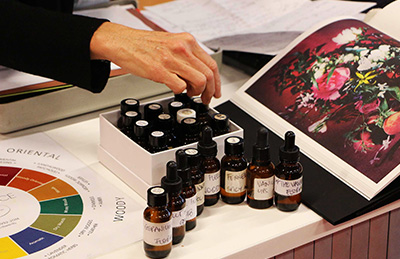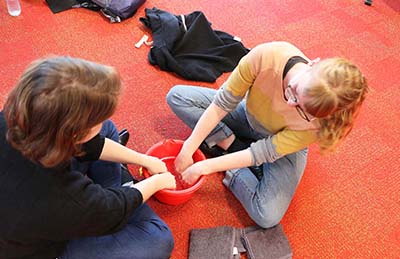NIDA’s Master of Fine Art (Cultural Leadership) students have been immersed in a wide variety of skills development and emotional contexts as they learn about empathy, imagination, neuroscience and research practice.

NIDA’s Master of Fine Art (Cultural Leadership) students have been immersed in a wide variety of skills development and emotional contexts as they learn about empathy, imagination, neuroscience and research practice. The students come from across the cultural spectrum, from political community theatre to mainstream ballet, major museums to regional Indigenous arts organisations, individual artists and more.
Empathy was top of the agenda in The Sensate Studio. Educator Dr Barbara Doran, a visual artist, filmmaker and creative cognition academic, led hands-on sessions on touch, taste, sight, hearing and smell alongside Suzanne Osmond, Graduate Course Convenor.
‘Engaging with the senses provides a direct route to our emotions,’ said Barbara. ‘Our emotions shape meaning and motivation and are primarily rooted in non-verbal pathways that house connections to memory and physical intelligence,’ she said.



‘Artists across mediums have always known this, but now neuroscience and embodied psychology can reveal how this happens. This marriage of art and science is one of the biggest emerging stories in how we understand the mind. Exploring the senses opens up tools and new narratives for nourishing our empathic capacities and our intuition.’
‘We engage with the senses as a way of invigorating creative engagement and building empathy,’ said Suzanne. ‘We are looking at the way these senses connect us socially and culturally and their relationship to storytelling.’
Barbara said that empathy is ‘a wonderful act of imagination where we put ourselves in another’s situation’ that draws on a ‘rich personal tapestry of memories’.
‘Much of this stored in our silent, limbic brain and the neurochemical soup of our changing bodies that our conscious brains are slow to register,’ she said. ‘Engaging with the senses exposes and expands access to the range of knowledge drawn from the experience. Smell is a good example – it can take us directly to a rich bank of memory, and the “flavour” of those memories can influence how we feel in the moment.’
What will the cultural leadership students take back into their workplaces?
Barbara explained that cultural leadership in Australia today is tasked with a complex range of challenges. ‘We’ve worked hard to get the ‘A’ (arts) into STE(A)M and part of this involves helping others to understand the value of skills, methods and intelligences embedded in arts practice. Cultural leaders are at the helm of generating a greater understanding and appreciation for the arts � it’s a two-way street.
‘Cultural leaders are increasingly working across disciplines such as health, science, education and finance. We are ever more aware that we can’t eliminate emotions in pursuit of rationalism and instead, have to engage with them to be effective. Understanding this nexus and the particular suite of skills the arts bring to the process is one of the most significant and exciting frontiers for this century.’
How does empowering creativity at work assist cultural leaders in their practice?
‘The world we occupy is increasing complex, paradoxical and often fraught with challenges. We invite a wider, tolerant and more imaginatively adaptable range of ourselves into the space when we are playful,’ said Barbara. ‘Generating space for these qualities, be it through policy, engagement, new ways of evaluating or working in diverse teams, are all part of the creative purview of leadership.’
Barbara advocated that cultural leadership itself is inherently creative. ‘Creativity involves synthesis of ideas and connections to open up new worlds of understanding. Developing habits that strengthen sensory fitness helps reach into the depths of our knowledge, forge new connections while also tapping the circuits that are critical to meaning making.’
‘Leadership nourishes co-operation, community and diversity. It fosters trust and generates space for diverse voices and practices of communication. A deeper understanding of the sense enriches compassionate leadership skills practically and conceptually. For example, simple storytelling exercises bouncing from colour memories can be a playful and generous pathway to a detailed landscape of memory and motivations.’
What are the broader social and cultural implications of this focus on the senses?
‘The growing evidence for our embodied intelligence includes countless fascinating studies – singing increases spatial awareness and when we use our hands diversely, whole regions of our brain light up,’ said Barbara. ‘Skin (our largest organ) will give off electro conductivity signals showing that we know something in our bodies before we consciously register the thought; our hearts have concentrations of neurons linked to feeling; our guts produce neurotransmitters involved in regulating mood, our gut instincts are real!’
‘With touch, for example, cross culturally we have shared understandings of people, their relationships to us and the regions of our body that are “ok” to be touched. At the same time different times and places are more or less “touchable”. If we can learn anything from the senses, it is that context is important and our bodies are always speaking – we just need to invite them into the conversation more. If we do this, we learn to appreciate and respect the continuum of perception.’
From empathy to data crunching


The intensive also included lectures and tutorials for the subject ‘Generating Research through Practice’, where the second-year Cultural Leadership students joined with other NIDA Master of Fine Arts students (Directing, Design for Performance and Writing for Performance). While the subject focuses primarily on practice-lead and qualitative research, this particular intensive looked at developing quantitative skills.
‘We need to be articulate and persuasive about the value of the arts to society and ‘hard data’ is important to convince stakeholders, as well as a useful skill for market-research and impact studies for the cultural sector. But these skills are usually taught in a rather dry way. As creatives and artists we learn effectively through visual and embodied means. Barbara is introducing us to the mean, average, coefficient and basically statistical analysis through play. This is really engaging and we can have fun while at the same time applying quantitative approaches. It’s like studio practice in a research environment’, said Cheryl Stock, Director, Graduate Studies and Head of Cultural Leadership.
Learn more about NIDA’s MFA (Cultural Leadership) at Open Day on Saturday 16 June. Register here: /courses/open-day
